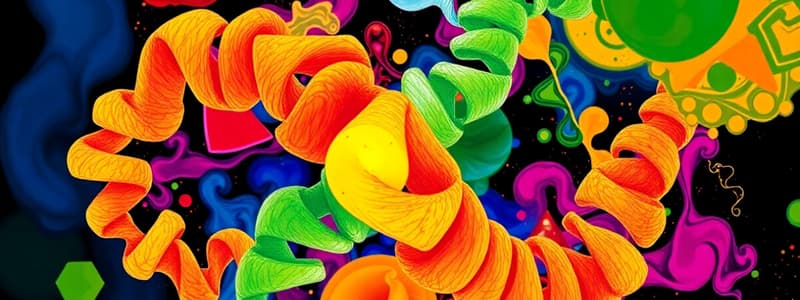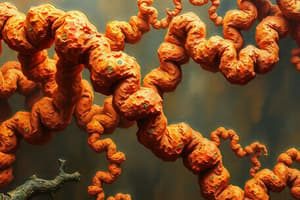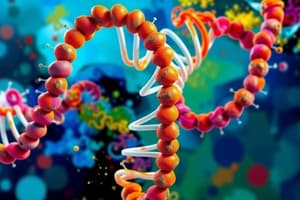Podcast
Questions and Answers
Which of the following statements about beta-turns is correct?
Which of the following statements about beta-turns is correct?
- Beta-turns only form in helical structures.
- Beta-turns consist of a four-residue spiral structure.
- Beta-turns allow protein chains to reverse direction. (correct)
- Proline and glycine are rare in beta-turns.
What defines a coiled coil structure in proteins?
What defines a coiled coil structure in proteins?
- Two helices unwound in a super-helix formation.
- A single helix twisted into a random coil.
- Two helices arranged parallel to one another.
- Two helices wound around each other in a supercoil. (correct)
Which of the following accurately describes random coil regions in proteins?
Which of the following accurately describes random coil regions in proteins?
- They are structured and conserved patterns of bonding.
- They are flexible and often engage in binding events. (correct)
- They consist solely of nonpolar residues.
- They have a repeating helical structure.
In a beta-hairpin super-secondary structure, how are the strands connected?
In a beta-hairpin super-secondary structure, how are the strands connected?
What characteristic of alpha-keratin contributes to its fibrous nature?
What characteristic of alpha-keratin contributes to its fibrous nature?
How do amino acid residues typically relate to secondary structure formation?
How do amino acid residues typically relate to secondary structure formation?
Which structure connects parallel beta-strands and forms a beta-alpha-beta motif?
Which structure connects parallel beta-strands and forms a beta-alpha-beta motif?
Which feature is not characteristic of the random coil in protein structures?
Which feature is not characteristic of the random coil in protein structures?
What is the primary role of the beta-turn in protein structures?
What is the primary role of the beta-turn in protein structures?
Which amino acids are predominantly found in beta-turn structures?
Which amino acids are predominantly found in beta-turn structures?
Which of the following statements best describes random coil regions in proteins?
Which of the following statements best describes random coil regions in proteins?
In the context of super-secondary structures, what does the beta-alpha-beta motif consist of?
In the context of super-secondary structures, what does the beta-alpha-beta motif consist of?
What structural feature helps maintain the fibrous nature of alpha-keratin?
What structural feature helps maintain the fibrous nature of alpha-keratin?
In protein structure, how are super-secondary structures defined?
In protein structure, how are super-secondary structures defined?
How does the left-handed twist of coiled coils affect the structure?
How does the left-handed twist of coiled coils affect the structure?
What is the significance of amino acid preferences in protein secondary structure formation?
What is the significance of amino acid preferences in protein secondary structure formation?
Which characteristic is not typically associated with the coiled coil structure?
Which characteristic is not typically associated with the coiled coil structure?
What type of bonding is primarily responsible for the stability of elastomeric protein structures?
What type of bonding is primarily responsible for the stability of elastomeric protein structures?
Flashcards are hidden until you start studying
Study Notes
Secondary Structures
- Helices primarily consist of alpha helices, beta sheets, beta turns, and random coils.
- Beta turns allow the protein chain to reverse direction with carbonyl C of one residue hydrogen-bonded to the amide proton of a residue three positions away.
- Two types of beta turns:
- Type I (common)
- Type II, differs in the orientation of the middle peptide bond.
Super-secondary Structures
- Comprise coiled coils, beta hairpins, beta-alpha-beta motifs, helix-turn-helix structures, Greek keys, alpha-alpha hairpins, and EF hands.
- Coiled coils involve two helices intertwining to form a supercoil, exhibiting a left-handed twist and reducing the number of residues per turn to 3.5, with sidechain positions repeated every 7 residues.
- Beta-hairpins consist of two adjacent anti-parallel strands linked by a loop of 2-5 residues.
Random Coil
- Connects helices and strands, characterized by diverse lengths and shapes.
- Represents regions without a recurring bonding pattern; typically located at the protein's surface.
- Contains hydrogen bonds between C=O and N-H groups and water; rich in charged and polar residues.
- Features flexible loops that play critical roles in binding events and are often non-conserved.
Amino Acid Preferences
- Amino acid residues show a preference for specific types of secondary structures, achieving accuracy of 50-80% in predictions.
α-Keratin
- A fibrous protein found in hair, nails, claws, horns, and beaks.
- Composed of 311-314 residue alpha helical rod segments, with non-helical N- and C-termini capping the structure.
- Primary structure features 7-residue repeats denoted as (a-b-c-d-e-f-g)n, with nonpolar residues (a and d) promoting helix association.
Tertiary Structure - Protein Domains
- Combination of secondary and super-secondary structures results in functional domains within proteins.
Secondary and Supersecondary Structures
- Secondary structures are stable configurations like alpha helices, beta sheets, beta turns, and random coils.
- Supersecondary structures consist of combinations of secondary elements, including coiled coils, beta hairpins, beta-alpha-beta motifs, and various helix-turn motifs.
β-Turn
- β-turns play a crucial role in enabling protein chains to change direction.
- Characterized by hydrogen bonding between the carbonyl C of one residue and the amide proton of a residue three residues away (first and fourth).
- There are two types of β-turns based on the orientation of the middle peptide bond: Type I (more common) and Type II.
- Proline and glycine are prominent in β-turns and facilitate the formation of antiparallel sheets.
- A β-turn can be visualized as a three-residue segment resembling a zero-pitch helix, with proline exhibiting a phi angle of -60.
Random Coil
- Random coils connect helices and strands via loop regions, which possess varied lengths and shapes.
- These regions are not truly random or coil-like but lack a recurring bonding pattern.
- Loops are typically found on the protein's surface and are rich in charged and polar residues.
- Hydrogen bonds between C=O and N-H groups and water contribute to their flexibility, allowing participation in binding events.
- Random coils are often variable and not conserved among different proteins.
Amino Acid Preferences
- Amino acids show a preference for specific types of secondary structures, achieving an accuracy of 50-80%.
Super-secondary Structures
- Beta-hairpins consist of two adjacent antiparallel strands connected through loops of 2-5 residues.
- The β-α-β motif includes two adjacent parallel β-strands linked by an α-helix positioned above the β-plane.
- Coiled coils comprise two helices spiraled around each other, forming a supercoil with a left-handed twist.
- This twist reduces the number of residues per turn to 3.5, while sidechain positions repeat every 7 residues.
α-Keratin
- α-Keratin is a fibrous protein found in hair, nails, claws, horns, and beaks.
- Comprised of alpha-helical rod segments consisting of 311-314 residues, capped with non-helical N- and C-termini.
- Its primary structure includes 7-residue repeats of the form (a-b-c-d-e-f-g)n, where a and d represent nonpolar residues; this structure aids in the formation of coiled coils.
Tertiary Structure - Protein Domains
- Tertiary structure is formed by the combination of secondary and supersecondary structures, leading to distinct protein domains.
Studying That Suits You
Use AI to generate personalized quizzes and flashcards to suit your learning preferences.





